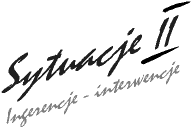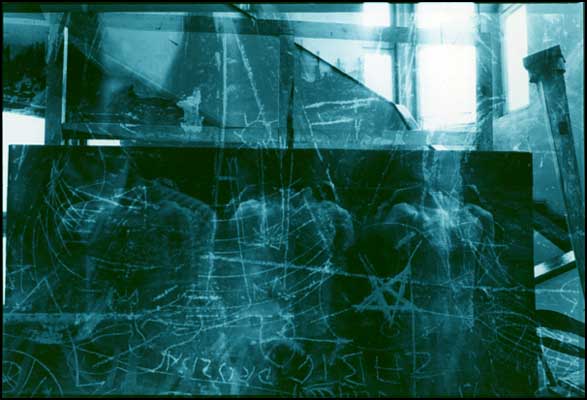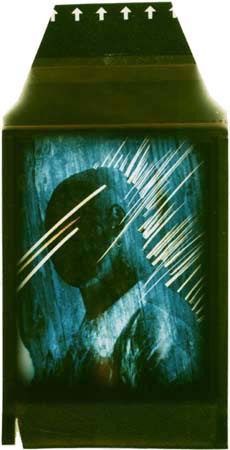
![]()


Dream Worlds
Anyone looking at the photographs by Witold Węgrzyn must really strain his or her eyes in order to work one's way through the net of scratches, lines and patches of darkness.But in effect we begin to reflect on the status of photographic images; we cease to perceive them as something taken for granted, something unquestionable.
These works are connected by similar poetics, they all seem to relate to the world of dreams. Their oneiric atmosphere is created by images of human shapes submerged in darkness, strangely lit and curiously framed pieces of furniture, for example chairs. Quite often the main object of presentation is the human face, sometimes enlarged to gigantic dimensions. It becomes a landscape in some way, or the whole universe, covering completely the surface of the frame. The impression of sleepy unreality is strengthened by colours, which subtly permeate all the photographs. /.../
Fictionality of Reality
Who knows if the most interesting motif in the works of Witold Węgrzyn is not the exposition of technological qualities of photography? Materiality of film is revealed: the perforated edges of the plate (usually cut to match the dimensions of the frame) and the smooth surface, vulnerable to scratches. The images also contain "errors" in photographic art - some photographs are over-exposed, some are under-exposed. Some images seem to be "untreated", as if their development never reached beyond the stage of a negative.
How should we interpret such ostentatious presence of technology? In the same way as self-reflexive fragments in contemporary literature, I think - as a sign of self-knowledge of the artist who knows "how it's done" only too well. Too well to help to strengthen the common belief that photography is the art of simple imitation of reality. And so Węgrzyn creates images which demonstrate their artificiality and reveal how photography comes into being behind the scenes. Such a strategy is directed against the fiction of photographic reality, since it unmasks the alleged character of the images which, after all, are merely a recording of a spectrum of light.
But it would be hard to say that it is a form of art characterized by sceptical disbelief in the sense of photography or the sense of creating "beauty" (whatever this term might mean). What is saved in Węgrzyn's photographs is something that Walter Benjamin, a German philosopher, calls "auratic" art. An aura is something that cannot be reduced to the materiality of a work of art. It is something additional, "something extra" that makes us treat a photograph or a sculpture not as an object or a thing, and thus we try to see meanings, cultural allusions and emotions in works of art.
Aura, not technology, seems to be the domain of photography of Witold Węgrzyn.
Aleksandra Ubertowska
(fragments of a review published in "Gazeta Wyborcza")


(...)The works of Witold Węgrzyn must be treated as compositions containing infinite forms. His photography is not representational art. Węgrzyn's pictures result from attempts to contaminate photography as photography. It seems that the main aim of the artist is to reveal the relations between an object and its image. Looking at the matter from a broader perspective one might say that what is at stake here is the relation between man and objects, between man's imagination and his given reality. Węgrzyn's art has more to do with photographing internal landscapes than with registering impressions elicited by our world. It is the act of an artist expressively accentuating the variety of his own moods. These latest works distance the artist from the classic understanding of photography because they are transformed so deeply that they cannot be seen as closed images of something or someone. /.../ Moreover, those dynamic and emotionally loaded photograms, or rather their deeper layers, speak about the erosion of time. They are signs of the merciless passage of time.
Adam Pawlak
(fragments of a review in "Pomerania")
Translated by Maciej Świerkocki

16 X - 6 XI '98
Biographical information
Copyright ©1998 Witold Węgrzyn, Galeria FF ŁDK